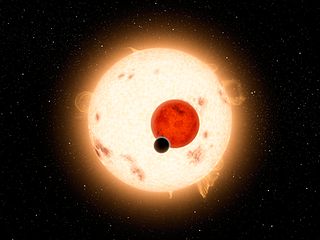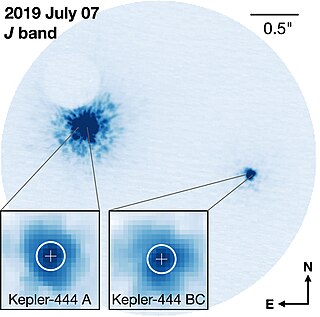Related Research Articles

The Extrasolar Planets Encyclopaedia is an astronomy website, founded in Paris, France at the Meudon Observatory by Jean Schneider in February 1995, which maintains a database of all the currently known and candidate extrasolar planets, with individual pages for each planet and a full list interactive catalog spreadsheet. The main catalogue comprises databases of all of the currently confirmed extrasolar planets as well as a database of unconfirmed planet detections. The databases are frequently updated with new data from peer-reviewed publications and conferences.
Kepler-5 is a star located in the constellation Cygnus in the field of view of the Kepler Mission, a NASA project aimed at detecting planets in transit of, or passing in front of, their host stars as seen from Earth. One closely orbiting, Jupiter-like planet, named Kepler-5b, has been detected around Kepler-5. Kepler-5's planet was one of the first five planets to be discovered by the Kepler spacecraft; its discovery was announced on January 4, 2010 at the 215th meeting of the American Astronomical Society after being verified by a variety of observatories. Kepler-5 is larger and more massive than the Sun, but has a similar metallicity, a major factor in planet formation.

Kepler-6 is a G-type star situated in the constellation Cygnus. The star lies within the field of view of the Kepler Mission, which discovered it as part of a NASA-led mission to discover Earth-like planets. The star, which is slightly larger, more metal-rich, slightly cooler, and more massive than the Sun, is orbited by at least one extrasolar planet, a Jupiter-sized planet named Kepler-6b that orbits closely to its star.
Kepler-8 is a star located in the constellation Lyra in the field of view of the Kepler Mission, a NASA-led operation tasked with discovering terrestrial planets. The star, which is slightly hotter, larger, and more massive than the Sun, has one gas giant in its orbit, Kepler-8b. This gas giant is larger than Jupiter, but is less massive, and thus more diffuse. The planet's discovery was announced to the public on January 4, 2010 along with four other planets. As the fifth confirmed planetary system verified by Kepler, it helped demonstrate the capabilities of the Kepler spacecraft.

Kepler-11e is an exoplanet discovered in the orbit of the sunlike star Kepler-11. It is the fourth of six planets around Kepler-11 discovered by NASA's Kepler spacecraft. Kepler-11e was found by using the transit method, in which the dimming effect that a planet causes as it crosses in front of its star is measured. Kepler-11e is most likely a gas giant like Neptune, having a density that is less than that of Saturn, the least dense planet in the Solar System. Its low density can probably be attributed to a large hydrogen and helium atmosphere. Kepler-11e has a mass eight times of Earth's mass and a radius 4.5 times that of Earth. The planet orbits its star every 31 days in an ellipse that would fit within the orbit of Mercury. Kepler-11e was announced on February 2, 2011 with its five sister planets after it was confirmed by several observatories.
Kepler-14b is an extrasolar planet in orbit around the primary star of the binary Kepler-14 system. It is currently the only planet known to exist in this star system. Kepler-14b is 8.4 times the mass of Jupiter and has a radius 1.14 times that of Jupiter, and it orbits its host star every 6.79 days. It was discovered by NASA-led Kepler mission, which noted the planet as a planetary candidate as early as March 2009, around the same time as the discovery of the first five planets discovered by Kepler. However, the team was unable to confirm the planet until extensive follow-up observations, as high-resolution imaging resolved the star Kepler-14 as a closely orbiting binary system. The Kepler team would have not noticed that Kepler-14 was a binary star based solely on initial radial velocity measurements, and found that if they had not realized this, their data on Kepler-14b would have been very inaccurate.
Kepler-39 is an F-type main sequence star located in the constellation Cygnus. It is located about 3,560 light-years away. One known substellar companion orbits it, Kepler-39b.
Kepler-15 (also known as KOI-128 or KIC 11359879 is a G-type main sequence star with a mass of 1.018 solar masses and a radius of 1.253 solar radius. The star lies at a temperature of 5595 Kelvin.

Kepler-16 is an eclipsing binary star system in the constellation of Cygnus that was targeted by the Kepler spacecraft. Both stars are smaller than the Sun; the primary, Kepler-16A, is a K-type main-sequence star and the secondary, Kepler-16B, is an M-type red dwarf. They are separated by 0.22 AU, and complete an orbit around a common center of mass every 41 days. The system is host to one known extrasolar planet in circumbinary orbit: the Saturn-sized Kepler-16b.
Kepler-87c is a planet orbiting Kepler-87, a star slightly more massive than the Sun and nearing the end of its main-sequence period.

Kepler-56 is a red giant in constellation Cygnus roughly 3,060 light-years (940 pc) away with slightly more mass than the Sun.
Kepler-421b is an exoplanet that, as of July 2014, has the longest known year of any transiting planet, although not as long as the planets that have been directly imaged, or many of the planets found by the radial-velocity method, or as long as some transiting planet candidates which are listed as planets in the Extrasolar Planets Encyclopaedia. It is the first transiting-planet found near the snow-line.
Kepler-440b is a confirmed super-Earth exoplanet orbiting within the habitable zone of Kepler-440, about 850 light-years (261 pc) from Earth. The planet was discovered by NASA's Kepler spacecraft using the transit method, in which the dimming effect that a planet causes as it crosses in front of its star is measured. NASA announced the confirmation of the exoplanet on 6 January 2015.

Kepler-444 is a triple star system, estimated to be 11.2 billion years old, approximately 119 light-years (36 pc) away from Earth in the constellation Lyra. On 27 January 2015, the Kepler spacecraft is reported to have confirmed the detection of five sub-Earth-sized rocky exoplanets orbiting the main star. The star is a K-type main sequence star. All of the planets are far too close to their star to harbour life forms.
Kepler-186b is an exoplanet located around 582 light-years away from Earth. Kepler-186b is orbiting a red dwarf known as Kepler-186, named after the space telescope that found it.
K2-66b is a confirmed mega-Earth orbiting the subgiant K2-66, about 520 parsecs (1,700 ly) from Earth in the direction of Aquarius. It is an extremely hot and dense planet heavier than Neptune, but with only about half its radius.
Kepler-411 is a binary star system. Its primary star Kepler-411A is a K-type main-sequence star, orbited by the red dwarf star Kepler-411B on a wide orbit, discovered in 2012.